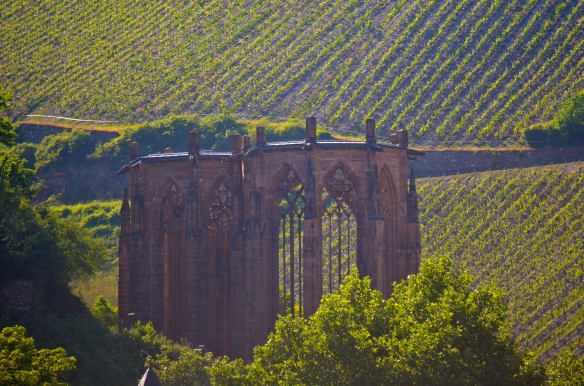One of the Rhine’s most renowned sections is the Rhine Gorge in Germany (aka the Middle Rhine, Rhine Valley and Romantic Rhine). Technically, this area starts in Mainz and ends in Koblenz (that area is the stretch of the river designated a UNESCO World Heritage Site). A boat trip down the Rhine is an excellent way to see the area’s magnificent landscape, towns, vineyards, castles and fortresses. We’d heard that the stretch between Bingen and St. Goar (which is a UNESCO World Heritage Site) was particularly beautiful. It was.
Castles + vineyards + valley = storybook cute There are at least 30 castles in the 66 kilometer (41 mile) stretch from Rudesheim to Koblenz. Why are there so many castles there?
The Rhine has been a major transport route since Roman times. Where there is money, there are those that want a piece of it. River barons built the castles to impose tolls on the river traffic by controlling their stretch of the river. If boat captains didn’t pay the toll, they would be treated to “complimentary room and board” in a dungeon until they paid.
From the dock at Bingen, we could see something that looked like the Statue of Liberty. We weren’t far off; it was Rüdesheim’s Niederwalddenkmal. Built by Kaiser Wilhelm I from 1881-3, it commemorates the founding of the German Empire after the end of Franco-Prussian War. Essentially, it sits near the French border and serves as a warning to France that they will get another whooping if they try to invade again (or at least that’s how it was explained to us).
The toll tower “Mäuseturm,” known as the Mouse Tower, was the first sight we saw from the boat. The name comes from a legend in which the tower belonged to a cruel ruler who oppressed and exploited the local peasants. in his domain. During a famine, he refused to distribute any of the tower’s grain supplies to the starving peasants. When they threatened to rebel, the ruler tricked them, telling them to wait in an empty barn for him to come with food. He ordered the doors barricaded and set fire to the barn, commenting “hear the mice squeak” (referring to their cries). Returning to his castle, an army of mice began to swarm him. He fled to the tower, they followed and ate him alive. Yikes!
We barely had time to listen to the story before seeing our first ruin, the ruin of Ehrenfels Castle (Burgruine Ehrenfels). The rapid succession continued for the rest of the trip. Wow! We were amazed.
Built in the early 1300’s on a strategic hilltop, is Burg Rheinstein. Prince Frederick of Prussia bought the castle and rebuilt the castle in the 19th century. Nearby the impressive medieval Burg Reichenstein is a now a modern hotel.
Burg Sooneck, also known as Saneck, Sonneck and Schloss Sonneck (click on the link to find out its relationship to Swiss history and the Battle of Sempach), was an infamous haunt of the river’s robber barons. The Crown Prince of Prussia, Frederick William IV, and his brothers Princes William, Charles, and Albert bought the completely derelict castle and rebuilt it as a hunting castle.
The tiny town of Niederheimbach has the 13th century Heimburg Castle and the little church called St. Mariae Himmelfahrt.
Lorch is a small town that has a lot for its size. You can easily spot it’s church, Pfarrkirche St. Martin (Saint Martin’s Parish Church), from the water. In the 18th century, the witch’s tower served as a sort of jail for wrongdoers and “witches”. The Nollig ruins (Ruine Nollig on the Rheinsteig trail), overlook the town and are the remains of the old town fortifications on the rugged ridge.
Bachrach is over 1,000 years old, and I thought we were getting a little long in the tooth. Just like the house of an octogenarian, it accumulated bits and bobs over time (the walkable city walls, 16 watchtowers, the picturesque “Malerwinkel”, the ruins of St. Werner’s Chapel). Stahleck Castle (Burg Stahleck), one of the most photogenic castles, sits on a hill above. It was destroyed by the French in 1689 and is now a youth hostel. I’ve stuck him in some cheap hostels before, but never a nice one like this.
Related articles
- Pont Du Gard (schwingeninswitzerland.wordpress.com)
- We Had Fun Storming Bellinzona’s Castles (schwingeninswitzerland.wordpress.com)
- Fresh Seaside Air Inland Thanks To Saline Towers (schwingeninswitzerland.wordpress.com)













Great stuff!
Thanks! I had too many photos for one post. Part two of the trip will be tomorrow’s post.
I absolutely love the castles and architecture!